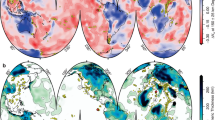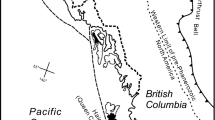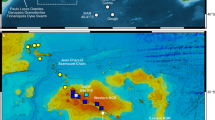Abstract
Recent Hawaiian volcanism is manifest as two geographically and geochemically distinct groups of volcanoes1, the Loa trend in the south and the Kea trend in the north2,3. The differences between the Loa and Kea lavas are attributed to spatial variations in the geochemical structure of the underlying Hawaiian mantle plume4,5,6,7,8,9. In turn, the Hawaiian plume structure is thought to reflect heterogeneities in its mantle source7,8. Here we compile geochemical data10 from the Hawaiian and two other volcanic ocean island chains—the Samoan and Marquesas—that formed above mantle plumes upwelling beneath the Pacific plate. We find that the volcanoes at both Samoa11 and the Marquesas12 show geographic and geochemical trends similar to those observed at Hawaii. Specifically, two subparallel arrays of volcanoes exist at both locations. In each case, the southern trend of volcanoes has higher radiogenic lead isotope ratios, 208Pb*/206Pb*, and lower neodymium isotope ratios, ɛNd, than those of the corresponding northern trend. We suggest that geochemical zoning may be a common feature of mantle plumes beneath the Pacific plate. Furthermore, we find that the pattern repeats between island chains, with the highest 208Pb*/206Pb* and the lowest ɛNdfound at Samoa in the south and the lowest 208Pb*/206Pb* and the highest ɛNd observed at Hawaii in the north. We infer that isotopically enriched material is preferentially distributed in the lower mantle of the Southern Hemisphere, within the Pacific low seismic velocity zone.
This is a preview of subscription content, access via your institution
Access options
Subscribe to this journal
Receive 12 print issues and online access
$259.00 per year
only $21.58 per issue
Buy this article
- Purchase on Springer Link
- Instant access to full article PDF
Prices may be subject to local taxes which are calculated during checkout




Similar content being viewed by others
References
Jackson, E. D., Silver, E. A. & Dalrymple, G. B. Hawaiian-Emperor chain and its relation to Cenozoic circumpacific tectonics. Geol. Soc. Am. Bull. 83, 601–618 (1972).
Abouchami, W. et al. Lead isotopes reveal bilateral asymmetry and vertical continuity in the Hawaiian mantle plume. Nature 434, 851–856 (2005).
Huang, S. et al. Enriched components in the Hawaiian plume: Evidence from Kahoolawe Volcano, Hawaii. Geochem. Geophys. Geosyst. 6, Q11006 (2005).
Lassiter, J. C., DePaolo, D. J. & Tatsumoto, M. Isotopic evolution of Mauna Kea volcano: Results from the initial phase of the Hawaiian Scientific Drilling Project. J. Geophys. Res. 101, 11769–11780 (1996).
Blichert-Toft, J., Weis, D., Maerschalk, C., Agranier, A. & Albarède, F. Hawaiian hot spot dynamics as inferred from the Hf and Pb isotope evolution of Mauna Kea volcano. Geochem. Geophys. Geosyst. 4, 8704 (2003).
Bryce, J. G., DePaolo, D. J. & Lassiter, J. C. Geochemical structure of the Hawaiian plume: Sr, Nd, and Os isotopes in the 2.8 km HSDP-2 section of Mauna Kea volcano. Geochem. Geophys. Geosyst. 6, Q09G18 (2005).
Farnetani, C. G. & Hofmann, A. W. Dynamics and internal structure of a lower mantle plume conduit. Earth Planet. Sci. Lett. 282, 314–322 (2009).
Farnetani, C. G. & Hofmann, A. W. Dynamics and internal structure of the Hawaiian plume. Earth Planet. Sci. Lett. 295, 231–240 (2010).
Weis, D. A. Daly Lecture: Geochemical Insights into Mantle Geodynamics and Plume Structure. Abstract V41F-01 presented at 2010 Fall Meeting, AGU, San Francisco, California, 13–17 Dec. (2010).
Jackson, M. G. et al. The return of subducted continental crust in Samoan lavas. Nature 448, 684–687 (2007).
Chauvel, C., Blais, S., Maury, R. & Lewin, E. Isotopic streaks suggest a stripy plume under the Marquesas. Eos Trans. AGU (Fall Meeting Suppl.) 90 abstr. V24A-05 (2009).
Burke, K., Steinberger, B., Torsvik, T. H. & Smethurst, M. A. Plume generation zones at the margins of large low shear velocity provinces on the core–mantle boundary. Earth Planet. Sci. Lett. 265, 49–60 (2008).
Morgan, W. J. Convection plumes in the lower mantle. Nature 230, 42–43 (1971).
Courtillot, V., Davaille, A., Besse, J. & Stock, J. Three distinct types of hotspots in the Earth’s mantle. Earth Planet. Sci. Lett. 205, 295–308 (2003).
Wolfe, C. J. et al. Mantle shear-wave velocity structure beneath the Hawaiian Hot Spot. Science 326, 1388–1390 (2010).
Hieronymus, C. F. & Bercovici, D. Discrete alternating hotspot islands formed by interaction of magma transport and lithospheric flexure. Nature 397, 604–607 (1999).
Hieronymus, C. F. & Bercovici, D. A theoretical model of hotspot volcanism: Control on volcanic spacing and patterns via magma dynamics and lithospheric stresses. J. Geophys. Res. 106, 683–702 (2001).
Galer, S. J. G. & O’Nions, R. K. Residence time of thorium, uranium and lead in the mantle with implications for mantle convection. Nature 316, 778–782 (1985).
Huang, S. & Frey, F. A. Recycled oceanic crust in the Hawaiian Plume: Evidence from temporal geochemical variations within the Koolau shield. Contrib. Mineral. Petrol. 149, 556–575 (2005).
Workman, R. K. et al. Recycled metasomatized lithosphere as the origin of the enriched mantle II (EM2) end-member: Evidence from the Samoan volcanic chain. Geochem. Geophys. Geosyst. 5, Q04008 (2004).
Salters, V. J. M., Blichert, J., Fekiacova, Z., Sachi-Kocher, A. & Bizimis, M. Isotope and trace element evidence for depleted lithosphere in the source of enriched Koolau basalts. Contrib. Mineral. Petrol. 151, 297–312 (2006).
Blichert-Toft, J., Frey, F. A. & Albarède, F. Hf isotope evidence for pelagic sediments in the source of Hawaiian basalts. Science 285, 879–882 (1999).
Hart, S. R. A large-scale isotope anomaly in the Southern Hemisphere mantle. Nature 309, 753–757 (1984).
Castillo, P. The Dupal anomaly as a trace of the upwelling lower mantle. Nature 336, 667–670 (1988).
Romanowicz, B. & Gung, Y. Superplumes from the core–mantle boundary to the lithosphere: Implications for heat flux. Science 296, 513–516 (2002).
Farnetani, C. G. & Samuel, H. Beyond the thermal plume paradigm. Geophys. Res. Lett. 32, L07311 (2005).
Druken, K. A., Kincaid, C. R. & Griffiths, R. W. Rollback subduction: The great killer of mantle plumes. Abstract U44A-06 presented at 2010 Fall Meeting, AGU, San Francisco, California, 13–17 Dec. (2010).
Panning, M. & Romanowicz, B. A three-dimensional radially anisotropic model of shear velocity in the whole mantle. Geophys. J. Int. 167, 361–379 (2006).
Kustowski, B., Ekstrom, G. & Dziewonski, A.M. Anisotropic shear-wave velocity structure of the Earth’s mantle: A global model. J. Geophys. Res. 113, B06306 (2008).
Ritsema, J., Deuss, A., van Heist, H. J. & Woodhouse, J. H. S40RTS: A degree-40 shear-velocity model for the mantle from new Rayleigh wave dispersion, teleseismic traveltime and normal-mode splitting function measurements. Geophys. J. Int. 184, 1223–1236 (2011).
Jackson, E. D. & Shaw, H. R. Stress fields in central portions of the Pacific plate: Delineated in time by linear volcanic chains. J. Geophys. Res. 80, 1861–1874 (1975).
Devey, C. W. et al. Giving birth to hotspot volcanoes: Distribution and composition of young seamounts from the seafloor near Tahiti and Pitcairn Island. Geology 31, 395–398 (2003).
Acknowledgements
We thank W. J. Morgan and C. Dalton for discussion, and A. W. Hofmann for constructive reviews.
Author information
Authors and Affiliations
Contributions
All three authors conceived the model, wrote the paper, prepared the figures, and contributed intellectually to the paper.
Corresponding author
Ethics declarations
Competing interests
The authors declare no competing financial interests.
Supplementary information
Supplementary Information
Supplementary Information (PDF 261 kb)
Supplementary Information
Supplementary Information (XLS 122 kb)
Rights and permissions
About this article
Cite this article
Huang, S., Hall, P. & Jackson, M. Geochemical zoning of volcanic chains associated with Pacific hotspots. Nature Geosci 4, 874–878 (2011). https://doi.org/10.1038/ngeo1263
Received:
Accepted:
Published:
Issue Date:
DOI: https://doi.org/10.1038/ngeo1263
This article is cited by
-
Earth’s mantle composition revealed by mantle plumes
Nature Reviews Earth & Environment (2023)
-
Evidence for compositionally distinct upper mantle plumelets since the early history of the Tristan-Gough hotspot
Nature Communications (2023)
-
New evidence for the Ontong Java Nui hypothesis
Scientific Reports (2023)
-
Progress in the numerical modeling of mantle plumes
Science China Earth Sciences (2023)
-
Mantle plumes and their role in Earth processes
Nature Reviews Earth & Environment (2021)



